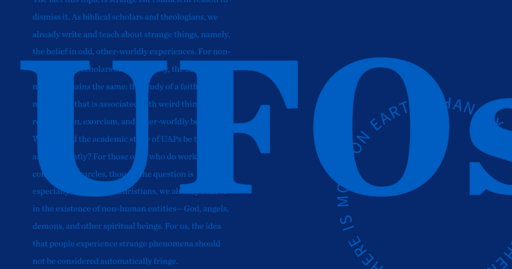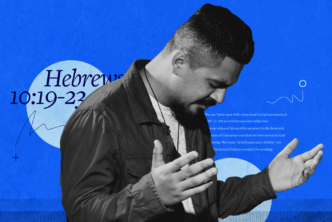Let me get straight to the point: I think biblical scholars and theologians should talk more about UFOs. Sounds crazy, right? But I’m not kidding.
Admittedly, this topic is a strange one. A person can hardly think of UFOs without hearing the eerie X-Files theme song crawl through their head. It’s a topic often associated with tinfoil hats and quirky people with effusive YouTube accounts. So why in the world—nay, galaxy—would I want my fellow academics to wade into these murky waters? I have three reasons: (1) public interest in the subject is increasing exponentially; (2) many highly respected secular academics have begun to speak out on the issue; and (3) the UFO topic often overlaps with traditional religion and the theological categories that pertain to it. Let me explain.
UFOs: from stigma to spotlight
An unrelenting social stigma has for a long time been associated with the UFO topic—ever since the 1940s, at least. So profound was the ridicule factor that many people, despite having a genuine interest in the subject, could never admit so in public. The stigma was especially acute for commercial and military pilots. For them, reporting a sighting meant risking not just their reputations but also their careers. Scientists and academics were especially careful to stay away from such a strange topic—at least publicly. Only liars, loons, and the confused claim to see UFOs, after all.
But everything changed in 2017, when The New York Times published a sensational story that revealed the Pentagon’s secretive study into the phenomenon. The topic has since gone mainstream. These days, everyone is talking about UFOs, which are known today as UAP: Unidentified Anomalous Phenomena. Almost overnight, the UAP woo factor evolved into a wow factor, capturing the attention of not the loons but some of the world’s leading academics and scientists. In the past, the topic lurked only in the shadows; today it gleams in the spotlight of public attention. It is no longer fringe.
Mainstream media outlets such as The New York Times, Politico, The Washington Post, Fox News, and CNN (to name a few) are now tackling the topic with seriousness. Award-winning journalists like Ross Coulthart and George Knapp are actively on the beat. (Knapp has actually been reporting on the topic for decades and is considered a legend in the field.) Indeed, it’s not unusual these days to hear influential senators like Kirsten Gillibrand (D-New York) or Marco Rubio (R-Florida) advocate for greater transparency on the topic. Congress even recently held a public hearing on the subject (you can watch it here).
Congress and UAPs
Recently, Congress passed the National Defense and Authorization Act (NDAA), which was subsequently signed by President Biden. The law requires the Pentagon to “establish a secure mechanism” for members of the military to report “any event relating to unidentified anomalous phenomena” (565). Any other day this alone would be newsworthy. But it’s tame compared to other parts of the law, which read like something straight out of science fiction. For example, this law requires the Pentagon to allow for the reporting of
any activity or program by a department or agency of the Federal Government or a contractor of such a department or agency relating to unidentified anomalous phenomena, including with respect to material retrieval, material analysis, reverse engineering, research and development, detection and tracking, developmental or operational testing, and security protections and enforcement. (566)
You read that right: The law now requires the Pentagon to allow for the reporting of “material retrieval” and “reverse engineering” of UAP. This is baffling, to say the least. Does Congress think it’s possible there exists recovered material—enough to have been the subject of scientific analysis and “reverse engineering”? Arguably, they think it’s more than possible. The fact this is a legal directive to the Secretary of Defense suggests that Congress thinks it’s plausible that people within the government have knowledge about the reverse engineering of UAP material. What has Congress seen behind closed doors that would make language like this remotely intelligible? I’m not sure. But many in the public—including leading scientists and academics—are taking note.
Academics and UAPs
Academics are often reluctant to comment on anything para-normal. Surprisingly, biblical scholars and theologians are no exception to the rule. This is something Dale Allison laments in his book Encountering Mystery with respect to how Christian scholars often treat near-death experiences.1 But there’s a revolution happening in the wider academic community. A growing number of highly-respected academics now actively investigate UAP. Dr. Garry Nolan at Stanford University is a prime example. A research immunologist, Nolan has published more than 300 articles, is the recipient of millions of dollars in research grants, and is the holder of more than three dozen patents. He’s the real deal. Perhaps it should be no surprise, then, that when the CIA wanted someone to conduct medical research on those who were exposed to UAPs, they requested his help. At first, he thought they were joking, but he soon discovered they weren’t. Today, Nolan routinely talks openly about the subject. While he admits that he doesn’t know what UAPs are, he’s adamant that “the data is real.” For him, UAPs are worthy of academic study.
And a Harvard physicist agrees. Dr. Avi Loeb is the former chair of the Harvard department of astronomy, with many peer-reviewed research articles to his name. Along with other recognitions and accolades, Dr. Loeb enjoys a fellowship at the American Academy of Arts & Sciences and has served on the U.S. President’s Council of Advisors on Science and Technology. His resume is impressive, to say the least. Dr. Loeb recently founded the Galileo Project, which, he says, “aims to unravel the nature of UAP.” The assumption behind this statement is, of course, that UAPs represent something real. In fact, in a recent conversation with Dr. Loeb, he told me that “it’s definitely real” and that the only question is what it is. His plan is to use his Galileo Project to harness the power of modern-day science to “clarify what these objects are.” The UAP topic, he says, is “intriguing” and worthy of scientific investigation.
UAP belief: a new religious movement?
But science isn’t the only player in the game. Religion gets time on the field, too. It is perhaps surprising how often the conceptual categories that belong to traditional religion come up in these discussions. One example comes from Luis Elizondo, a former Department of Defense intelligence official who was tasked with studying the phenomena in a program known as the Advanced Aerospace Threat Identification Program (AATIP). Elizondo has claimed that senior officials within the Pentagon pushed against investigations into UAP because, in their view, it represented something demonic. The late Senator Harry Reid said the same thing, validating Elizondo’s claims. Whatever UAPs actually are is, in many ways, irrelevant at this point. The fact that belief in spiritual beings is even being discussed in public settings—and in the highest levels of the US government—is itself an open invitation to scholars working in the relevant fields to enter the conversation.
More to the point, it is arguably the case that the relationship between religion and UAPs is much closer than one might realize. So says Dr. Diana Pasulka, a professor of religious studies at the University of North Carolina, Wilmington. In her book, American Cosmic: UFOs, Religion, Technology, Professor Pasulka makes the argument that belief in the UFO phenomenon often resembles religious devotion. Indeed, it’s “a new form of religion.”2 She writes:
A UFO sighting or event often has the effect of completely changing the direction of one’s life, much like a religious conversion experience.3
Whether the phenomena are real or not is beside the point; the fact that there is a widespread belief that they are real and that such belief evokes effects in the real world are enough to warrant investigation from a sociological—and, surely, religious—perspective.4 Given that religion and theology often come up in these discussions, careful theological thinking on the matter is necessary.
Though it’s wise to remain agnostic with respect to the origin of UAP, it’s becoming increasingly difficult to deny its reality. In light of this, Christian scholars must be prepared for the inevitable questions:
- Do UAPs represent another form of life? If so, what kind?
- If they are intelligent, what sort of ontological status would they hold within God’s creation?
- Would the existence of extraterrestrials change the Judeo-Christian view that humans are unique divine image bearers?
As we craft biblically and theologically coherent answers to such questions, we would do well to draw upon the wisdom of Christian thinkers such as C. S. Lewis, whose Space Trilogy and The Discarded Image both offer insights for how we might think about the UAP topic. To be sure, many confessional scholars are already addressing these issues. Dr. Paul Thigpen, for example, recently published an excellent book that discusses the subject with respect to various doctrinal questions. The late Dr. Michael Heiser has for years been writing and lecturing on the subject and even filmed a UFO documentary. Others could be mentioned as well.
But more discussion is needed. As Christian scholars, we should address this topic via peer-review, conference presentations, and public forums. We should also seek collaboration with those working in the natural sciences in order to facilitate robust discussion and meaningful dialogue. This will ensure a careful and thoughtful approach to the subject—a necessary move, I think, since UAPs potentially represent a reality so complex that it will require nothing less than a rigorous interdisciplinary approach.
Reconsidering strange
The fact this topic is strange isn’t sufficient reason to dismiss it. As biblical scholars and theologians, we already write and teach about strange things, namely, the belief in odd, other-worldly experiences. For non-confessional scholars of Christianity, the subject matter remains the same: the study of a faith movement that is associated with weird things like resurrection, exorcism, and other-worldly beings. Why should the academic study of UAPs be treated any differently? For those of us who do work in confessional circles, though, the question is especially relevant. As Christians, we already believe in the existence of non-human entities—God, angels, demons, and other spiritual beings. For us, the idea that people experience strange phenomena should not be considered automatically fringe.
Perhaps we can learn from Dale Allison’s recent book, Encountering Mystery (mentioned above). Professor Allison is a New Testament scholar at Princeton Theological Seminary, and when it comes to being a highly-respected academic, he’s at the top of the list. But he’s not afraid to talk about his own experiences, no matter how strange they were—and some of them were very strange.5 Commenting on one bizarre personal anecdote involving a mysteriously disappearing and reappearing honey jar, he says,
This outlandish experience, all by itself, tells me that there is more on earth than my science teachers imagined. The world must be far odder than we regularly take it to be.6
I’m sympathetic with Allison’s conclusion, as I know for a fact that people have experiences that don’t fit well within a materialist paradigm—I’ve had one myself. As I’ve shared my own story to friends and colleagues through the years, I discovered something surprising: many people I spoke with, including scholars, have had their own strange experiences. Apparently, extraordinary things happen to ordinary people.
Reports of such experiences can be traced back thousands of years. How strange it must have been for the shepherds to see non-human entities announce the birth of the Messiah (Luke 2:8–20). How odd for the Magi to see a strange light in the sky, leading them on a life-changing journey (Matt 2:1–2). Perhaps stranger still is the fact that we can read these timeless stories without realizing just how strange they actually are. Have we Christians become so familiar with the biblical stories that they have become less weird, less strange—and over time, more tame?
I’m not suggesting that the shepherd’s angels or the star of Bethlehem were Unidentified Anomalous Phenomena—not for a minute. Scripture does identify them. What I am saying is that, if there are reasons why biblical scholars and theologians should not contribute to the UFO/UAP discussion, the fact that it’s strange should not be one of them.
- Dale C. Allison, Jr., Encountering Mystery: Religious Experience in a Secular Age (Grand Rapids: Eerdmans, 2022), 139-140.
- D. W. Pasulka, American Cosmic: UFOs, Religion, Technology (New York, NY: Oxford University Press, 2019), 216.
- Pasulka, American Cosmic, 185.
- See Pasulka, American Cosmic, 215-239, esp 216.
- See e.g., Allison, Encountering Mystery, 1-7, 165-170.
- Dale C. Allison Jr., Encountering Mystery: Religious Experience in a Secular Age (Grand Rapids, MI: William B. Eerdmans Publishing Company, 2022), 167.







